Modern long-playing smartphones with a large battery: compare the flagship innos D6000 with peers and competitors
Hello! In a post about the first results of the innos brand launch on the Russian market, information was given about which devices were purchased instead of innos D6000 . Alas, not everyone waited for our apparatus, taking as a result other models. Due to the circumstances described in the same post, the release of our model was a little delayed, and some people did not tolerate the start of sales. Well, failed buyers had every right to do so. At the same time, most of them, for which they thank them separately, did not hide - what was bought in the absence of official innos D6000.
In this review, I will compare innos D6000 with these “smartphones-substitutes”. True, not with all. Some comrades bought the iPhone and Samsung, which, as you know, are quite ordinary batteries. Apparently, these people wanted either an image apparatus or a long-playing one. The second was not available, well, damn it with this autonomy - I’ll take just an image! (This approach is not close to me, but it has the right to exist).
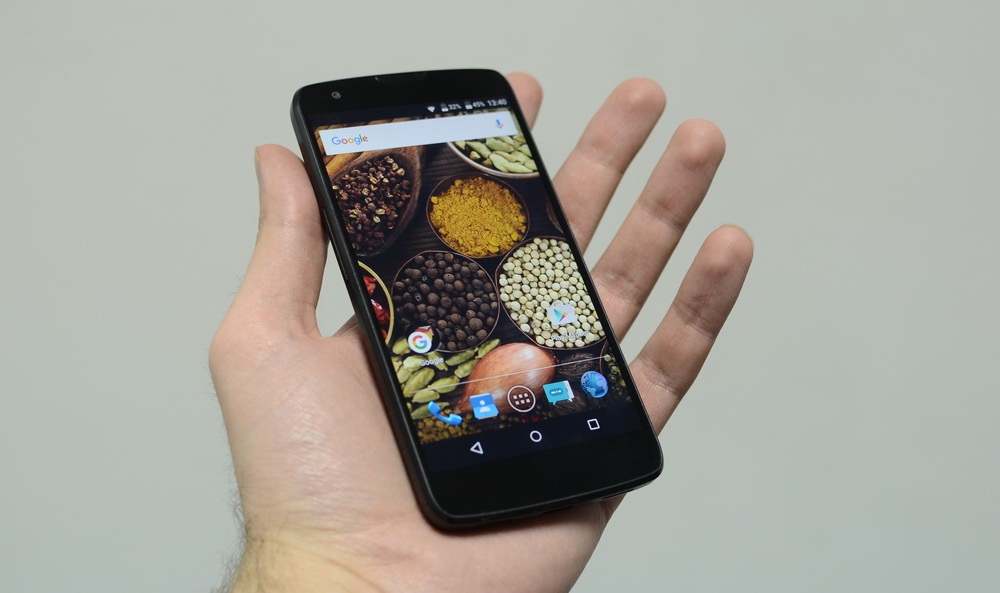
')
In general, in this review I collected the devices purchased by people instead of innos D6000, with batteries with capacity from 4,000 mAh and more. I emphasize that in the middle of 2016, 3,000 mAh is already the base level for a typical modern smartphone. Yes, last year it was a bit more than average, but now it is no longer. Let's say there is a mass of Samsung devices with such batteries, and they are never positioned, and even more so are not long-playing. It is a matter of 4,000 mAh: this is already noticeably more than the average, and this amount allows us to hope for some additional “piece” of work time.
As many know, Xiaomi smartphones are now officially entering the Russian market - they will be sold in Euroset and Svyaznoy. Therefore, I will build on the official prices of Xiaomi devices. As for Redmi 3, the so-called improved version of this model will be sold in Russia, in some sources called Xiaomi Redmi 3 Pro. It has 3 GB of RAM and 32 GB of internal memory (instead of 2 and 16 GB in the usual Redmi 3), plus a fingerprint scanner has been added. This device costs 14,990 rubles, and it is equipped with a 4,100 mAh battery. Innos D6000 with 6,000 mAh costs a thousand rubles more, that is 15 990. What are the advantages of Xiaomi? In the fingerprint scanner, as well as in a metal case. What wins D6000? The screen resolution of the D6000 is higher: 1920 x 1080 pixels. Slots for SIM-cards in innos D6000, let's say, are full and separate: you can insert two SIM cards and a memory card at once. In the case of Xiaomi, you can either SIM + SIM, or SIM + MicroSD. The resolution of the camera is also higher with the innos D6000: 16 megapixels versus 13. The convenience of the interface connector is also on the innos side: it uses a symmetrical USB Type-C, and not an archaic MicroUSB, like in Xiaomi. Finally, according to the Svyaznoy website, Redmi 3 only supports LTE Band 1, 3 and 7, which is not enough for full-fledged work in Russian networks of the fourth generation. innos D6000, by comparison, is “friendly” with Band 20, 38, and 40.
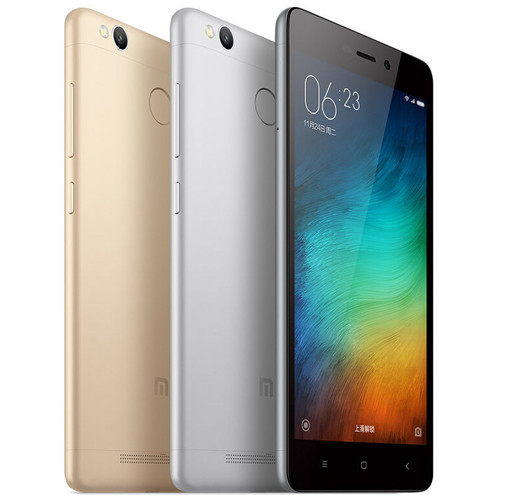
Despite the “turbocharging” in the form of increased amounts of RAM and ROM, the Xiaomi Redmi 3 is still inferior to the innos D6000 in most parameters, being simply a less modern machine. He has one key tangible advantage - a metal case. In other parameters, the advantage is on the innos side. And in terms of battery life too: 4,100 mAh can not be charged with 6,000 mAh, even though the screen resolution of the Xiaomi Redmi 3 is slightly lower than that of the innos D6000.
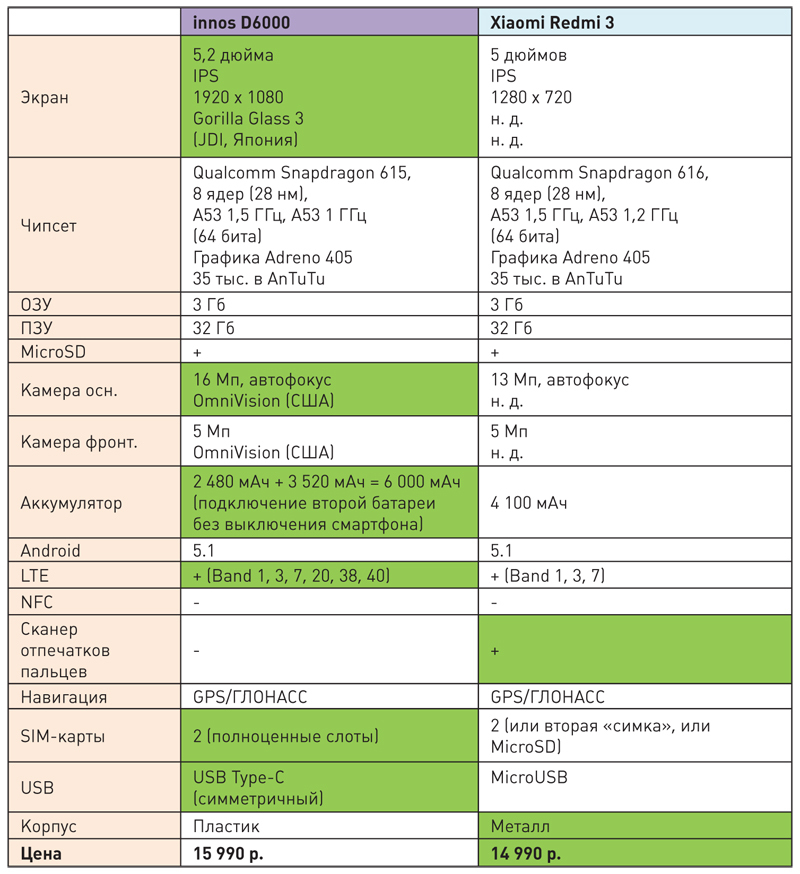
In this case, the developers decided to “cross over” a 5.5-inch Full HD screen with a 4,000 mAh battery and MediaTek Helio X10 chipset. Practice shows that due to the graphics accelerator PowerVR G6200 and higher frequencies of computational cores, it is somewhat more productive than Qualcomm Snapdragon 615. However, in reality there is no difference - neither in the speed of the OS interface, nor in games. But for autonomous work, the choice in favor of the MediaTek solution looks somewhat strange - it’s no secret that, other things being equal, the decisions of this office almost always turn out to be more voracious than Qualcomm. So ... In general, the advantages of Redmi Note 3 are the same as those of Redmi 3, a fingerprint scanner and a metal case. Plus - for special lovers of “parrots” - higher performance in benchmarks (a quarter more: 45 thousand points in AnTuTu against 35 for innos D6000).
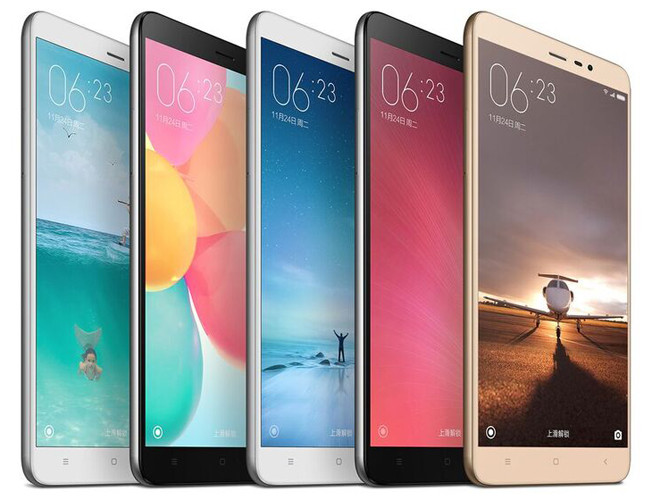
The advantages of the innos D6000 include everything that I listed in the previous section. Namely: a USB Type-C port, a much longer battery life at the expense of a 6,000 mAh battery, support for all LTE bands relevant for Russia, a 16 megapixel camera. Plus a microSD card slot, as in Redmi Note 3 it is not at all. Against this background, the option Xiaomi with 2 GB of RAM and 16 GB of internal memory, of which a good third will be inaccessible to the user, looks for its 15,990 rubles in general ridiculous. Option 3 and 32 GB is already 17,990 against 15,990 in the case of innos. Is it worth it to overpay 2 thousand for the metal and get a bunch of cons in the load - you decide.
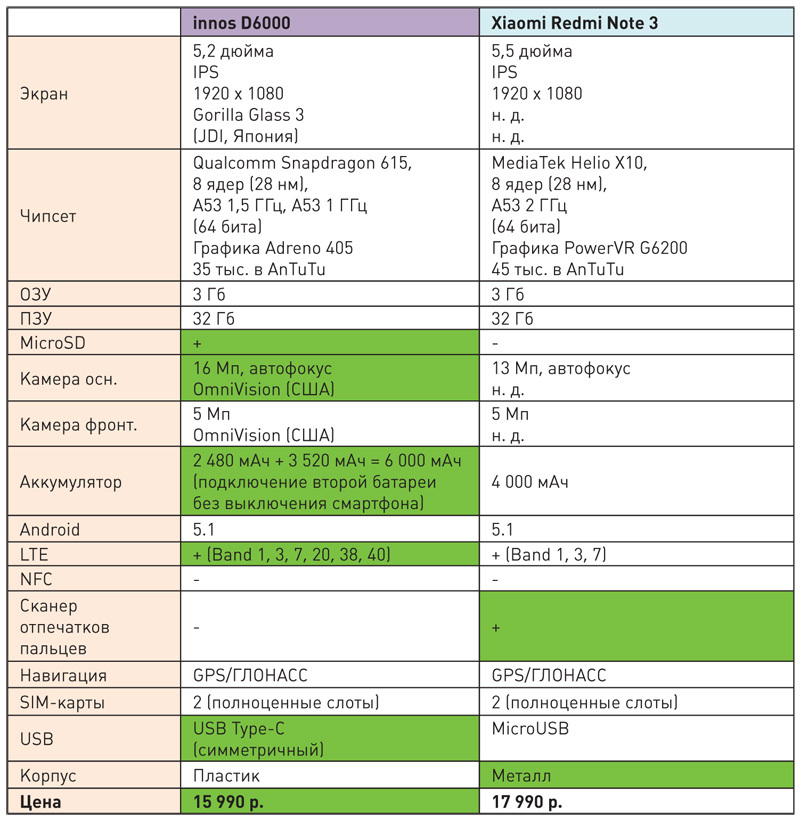
JSR, owner of the innos brand, developed the Boost, Boost 2 and Boost 2 SE models for Highscreen. But then the collaboration stopped, and JSR has nothing to do with Boost 3 / Boost 3 Pro. It is even more interesting to find out what happened with Highscreen in cooperation with a nameless Chinese factory.
The Highscreen Boost 3 Pro comes with two batteries - 3,000 and 6,000 mAh. Together they can not work. That is, either one or the second. Some people believe that 9,000 mAh is much better than 6,000 mAh for the innos D6000. But let's count. Highscreen Boost 3 Pro costs 21 thousand rubles. Innos D6000 - 16 thousand. Add here one additional battery for 3 520 mAh for 990 rubles from innos.com/ru - and we get 17 thousand rubles and a total capacity of 9 520 mAh. Moreover, removable batteries can be changed without turning off the smartphone, and not work with one or the other, as in the case of Highscreen Boost 3 Pro. But you can also buy from innos D6000 not one battery for 990 rubles, but two, three, five, ten - as many as you like.
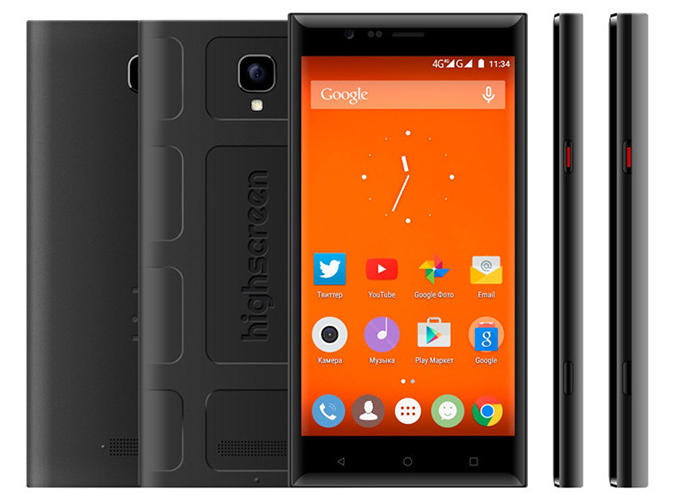
In terms of memory (3 GB of RAM + 32 GB of ROM), smartphones are the same; in terms of screen resolution - also (1920 x 1080) in performance - the same. True, MediaTek's chipset is involved in Highscreen, and we already spoke about the love of this company’s platforms for squandering energy in an unknown direction. So it's not entirely clear why the MediaTek solution was chosen for the long-playing smartphone. The camera in the Boost 3 Pro is weaker (13 megapixels versus 16 in the innos D6000), the microUSB port versus the USB Type-C in the innos D6000. On the side of the Highscreen solution, there is a high-quality sound in the headphones, which is obtained due to an expensive, isolated audio chip. However, in order to feel this very megaphone, you need to buy headphones that stand at half Boost 3 Pro, or even more. How many will buy them? The big question.
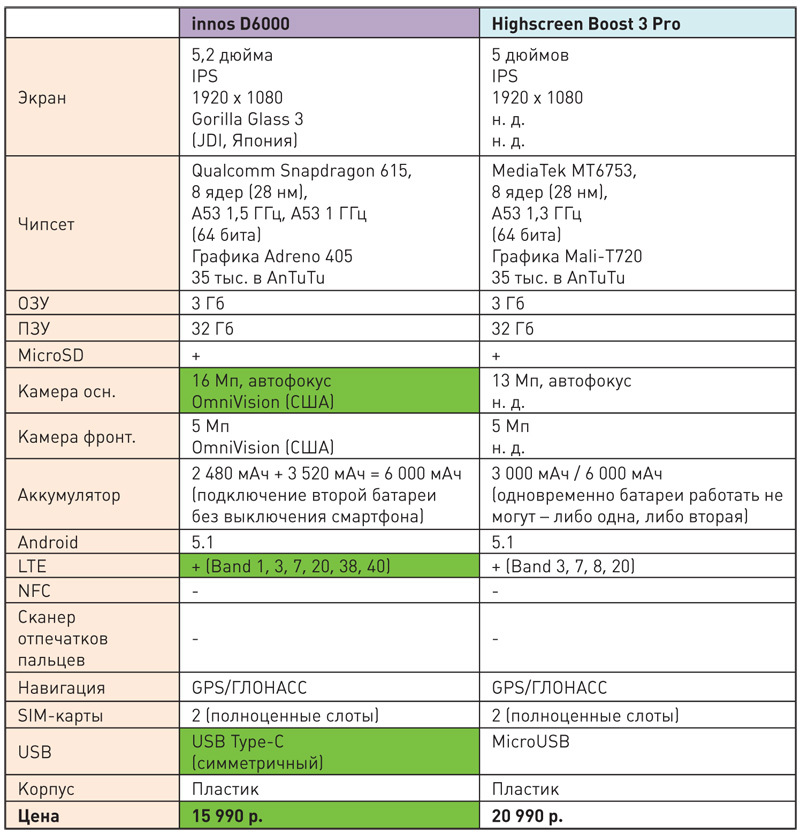
Everything here is quite simple and therefore boring. The Highscreen model is significantly inferior to the innos D6000 in all respects, and it costs exactly the same. Actually, this is an excellent illustration of the benefits of direct sales (for details, see this link ): due to the absence of retail networks, innos can offer its very sophisticated device for 15,990 rubles, but the more "weak" version from Highscreen is sold through retail networks, and therefore It costs the same 15,990 rubles.
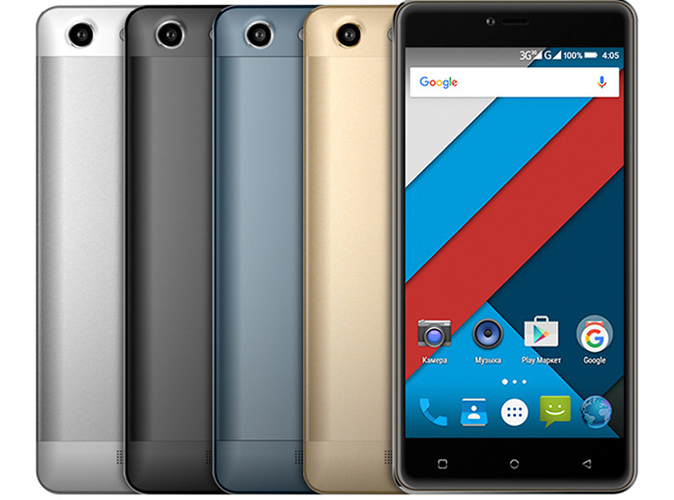
However, due to the 5,000 mAh battery, an economical AMOLED screen and a weak 4-core chipset (albeit from MediaTek again), Highscreen Power Five Pro is comparable to the innos D6000 autonomy. But innos D6000 offers much more features, nice options and operating comfort.
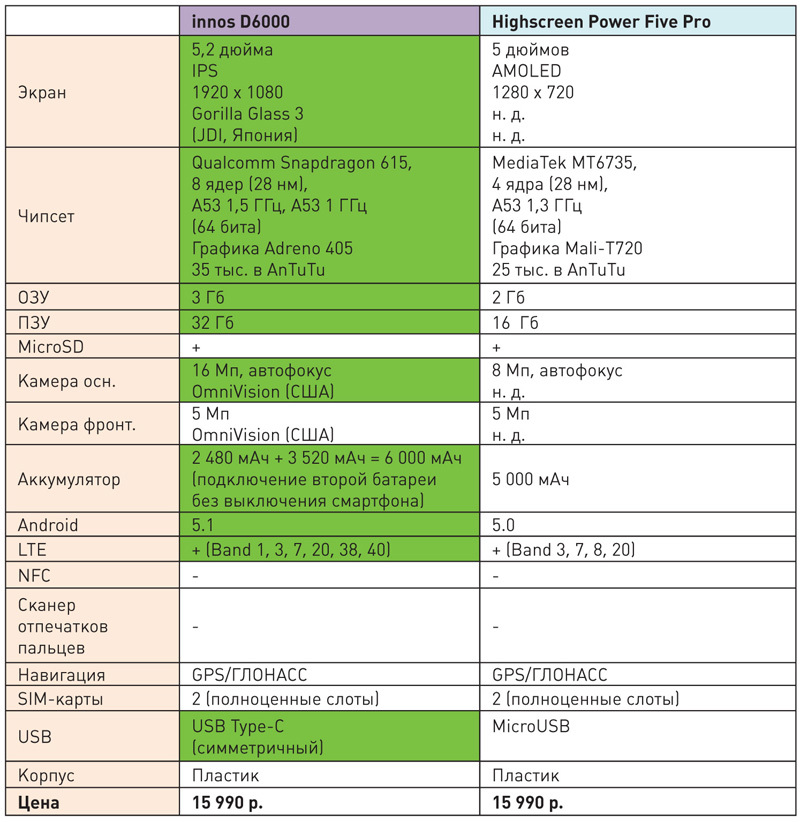
Lenovo has turned out quite a strange device for our realities. Let's start with the fact that he has one SIM card slot. In addition, the smartphone is running Android 4.4 KitKat, more than a year as outdated. Will the update to 5.0 or 5.1 - is unknown, and the “six” is hardly to be expected at all. As for the screen, it is 5.5-inch. This is a strange choice for a smartphone that focuses on long battery life.
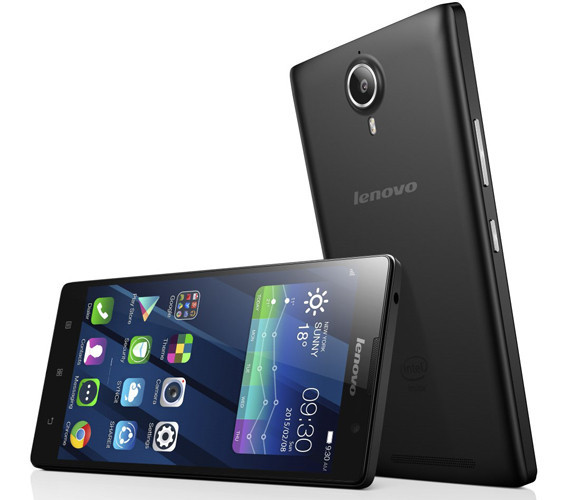
The strengths of the Lenovo P90 Pro - as much as 4 GB of RAM and as much as 64 GB of internal memory, but without the support of memory cards. The hardware platform is Intel Atom Z3560, in terms of performance it roughly corresponds to the Snapdragon 615. The resolution of the camera is higher for the innos D6000 (16 Mp vs. 13 for Lenovo), the interface port is more modern and more convenient for it (USB Type-C vs. MicroUSB), battery capacity innos is also higher in the product (6,000 vs. 4,000 mAh), as is the battery life. In general, Lenovo P90 Pro looks like a newcomer from the past (if you close your eyes to 4 GB of RAM), and the low price is due to the subsidy from Intel. Just a Santa Clara corporation is still generously sponsoring manufacturers who run the risk of releasing smartphones on its not very popular hardware platforms.
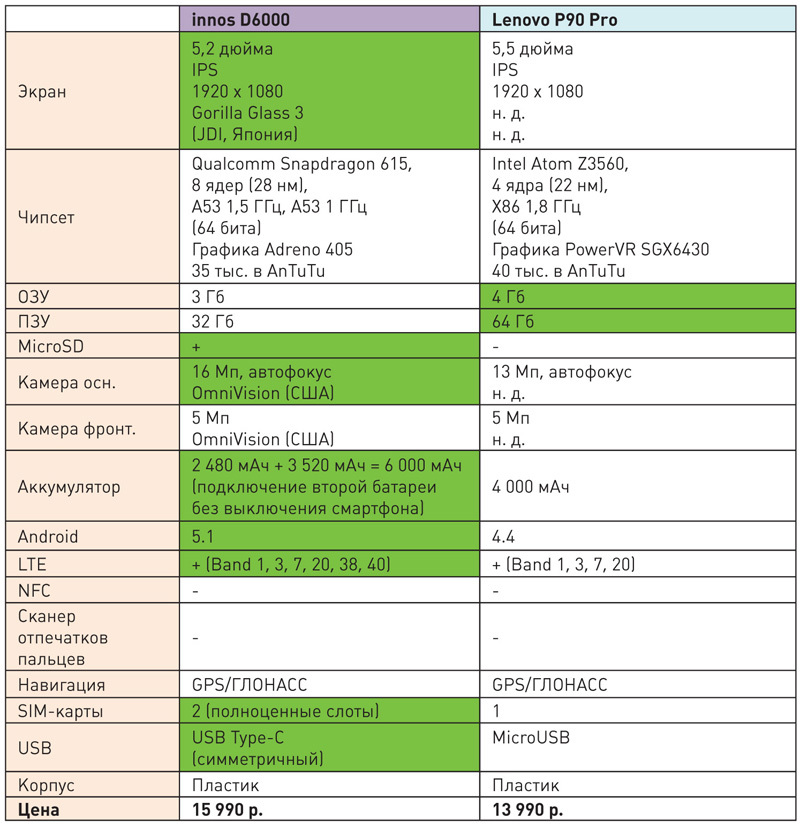
This unit looks much more modern than the P90 Pro. He has two slots for SIM-cards (you can put a pair of "simok", and at the same time with them MicroSD), 32 GB of internal memory, support for NFC, fingerprint scanner, metal case, Android OS 6.0 Marshmallow. The form factor is again 5.5-inch, which, again, is not the best option for a long-playing smartphone - the larger the screen, the more energy it eats.
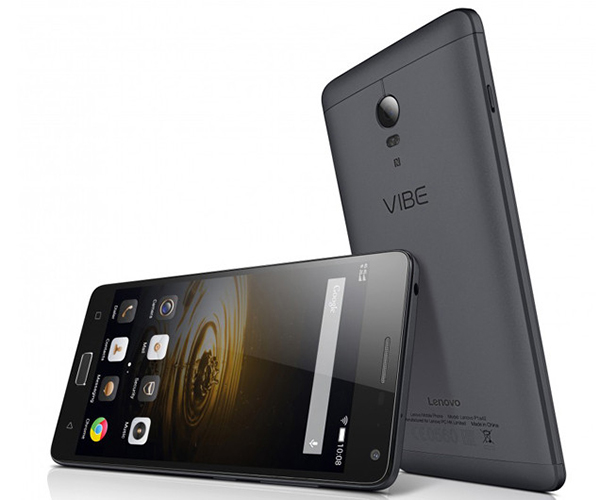
The better than this smartphone, our hero - innos D6000? A more powerful battery that, together with a 5.2-inch display, provides a longer battery life, a USB Type-C port, a 16-megapixel camera, 3 GB of RAM. On the side of Lenovo - metal, NFC, fingerprint scanner, Android 6.0. True, this summer innos D6000 will also receive Marshmallow, and the devices will be equal in this parameter. In general, Lenovo Vibe P1 is a good modern smartphone with increased, but not maximum autonomy.
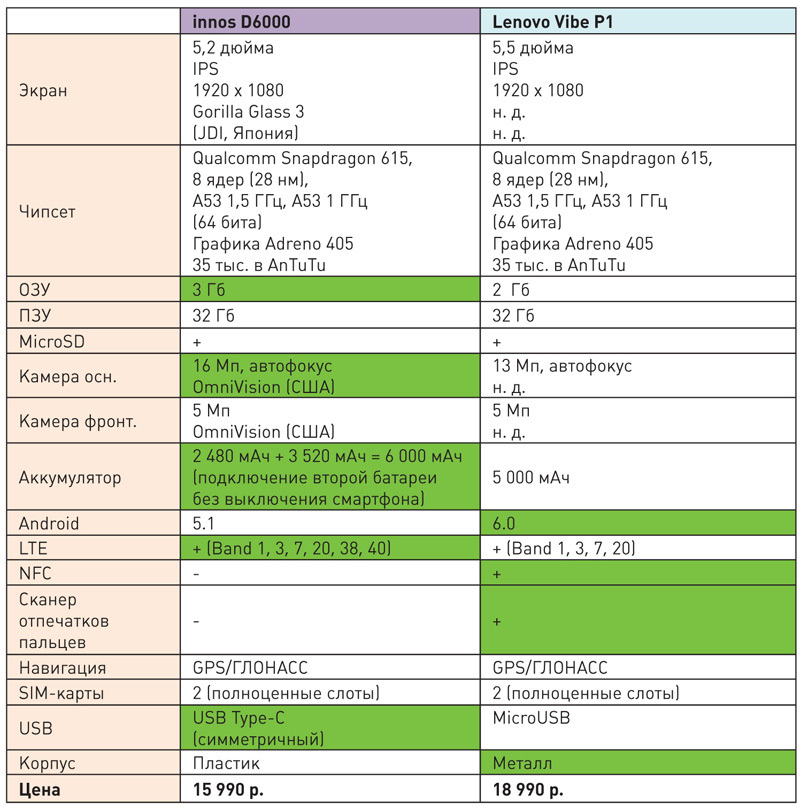
The smartphone resembles Highscreen Power Five Pro, except that the battery here is not 5,000 mAh, but 4,000 mAh, and the screen is not AMOLED, but IPS. Otherwise, everything is very similar. Lenovo Vibe P1m innos D6000 loses in all parameters, however, it costs a thousand rubles cheaper.

Whether it is appropriate to save in this case is up to the consumer. But, I think, a thousand rubles is not the amount that should be kept in your pocket, choosing a modern smartphone. Because, having spent 15,990 instead of 14,990 rubles, you can get a device that overtakes Lenovo Vibe P1m by a year and a half or two.
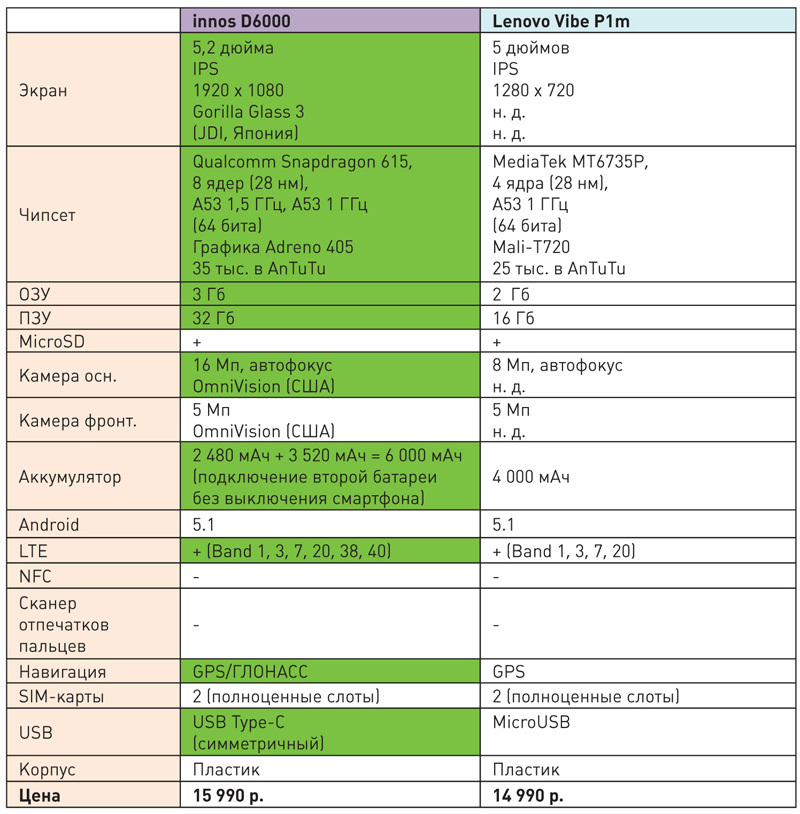
A kind of "hybrid" Highscreen Power Five Pro and Lenovo Vibe P1m: the model ASUS has a 5000 mAh battery, and the screen is an IPS with a resolution of 1280 x 720 pixels. True, again, 5.5-inch, which is not very good for long-lived smart. In general, both in terms of battery capacity and display quality, the ZenFone Max loses innos D6000. The performance is quite low: there is not much to expect from the Qualcomm Snapdragon 410 chipset, there are brakes in some games and even in the interface.

The battery life of ASUS ZenFone Max and innos D6000 are comparable, but, again, in the first case, we actually have a budget device with the appropriate hardware and capabilities, and in the second case - quite modern and ready to solve almost any problem. The prices of the models are the same.

What can be said in the end? For all options related to autonomous work and its provision, innos D6000 seriously outperforms any of the long-playing competitors. And rightly deserves its title of the most thoughtful long-lived smartphone. Because the developers did not use a 5.5-inch screen and stopped at a 5.2-inch - he eats much less energy. Because they did not bother with the dubious (in terms of energy efficiency) MediaTek solutions, but took Qualcomm, but not the weakest one. With a weak (like Snapdragon 410) innos D6000 would work a little longer, but much slower, which would have affected usability. Well, of course, it is worth highlighting the possibility of hot-swappable removable battery and the ability to purchase any number of such batteries. None of the competitors offer such a solution at all, and this is not surprising - this technology is the intellectual property of innos. So for 15,990 rubles (thanks to direct sales), the innos D6000 has no analogs - according to the balance of autonomous work and characteristics, no more expensive, or cheaper, or similar smartphones can afford it.
In this review, I will compare innos D6000 with these “smartphones-substitutes”. True, not with all. Some comrades bought the iPhone and Samsung, which, as you know, are quite ordinary batteries. Apparently, these people wanted either an image apparatus or a long-playing one. The second was not available, well, damn it with this autonomy - I’ll take just an image! (This approach is not close to me, but it has the right to exist).

')
In general, in this review I collected the devices purchased by people instead of innos D6000, with batteries with capacity from 4,000 mAh and more. I emphasize that in the middle of 2016, 3,000 mAh is already the base level for a typical modern smartphone. Yes, last year it was a bit more than average, but now it is no longer. Let's say there is a mass of Samsung devices with such batteries, and they are never positioned, and even more so are not long-playing. It is a matter of 4,000 mAh: this is already noticeably more than the average, and this amount allows us to hope for some additional “piece” of work time.
Xiaomi Redmi 3
As many know, Xiaomi smartphones are now officially entering the Russian market - they will be sold in Euroset and Svyaznoy. Therefore, I will build on the official prices of Xiaomi devices. As for Redmi 3, the so-called improved version of this model will be sold in Russia, in some sources called Xiaomi Redmi 3 Pro. It has 3 GB of RAM and 32 GB of internal memory (instead of 2 and 16 GB in the usual Redmi 3), plus a fingerprint scanner has been added. This device costs 14,990 rubles, and it is equipped with a 4,100 mAh battery. Innos D6000 with 6,000 mAh costs a thousand rubles more, that is 15 990. What are the advantages of Xiaomi? In the fingerprint scanner, as well as in a metal case. What wins D6000? The screen resolution of the D6000 is higher: 1920 x 1080 pixels. Slots for SIM-cards in innos D6000, let's say, are full and separate: you can insert two SIM cards and a memory card at once. In the case of Xiaomi, you can either SIM + SIM, or SIM + MicroSD. The resolution of the camera is also higher with the innos D6000: 16 megapixels versus 13. The convenience of the interface connector is also on the innos side: it uses a symmetrical USB Type-C, and not an archaic MicroUSB, like in Xiaomi. Finally, according to the Svyaznoy website, Redmi 3 only supports LTE Band 1, 3 and 7, which is not enough for full-fledged work in Russian networks of the fourth generation. innos D6000, by comparison, is “friendly” with Band 20, 38, and 40.

Despite the “turbocharging” in the form of increased amounts of RAM and ROM, the Xiaomi Redmi 3 is still inferior to the innos D6000 in most parameters, being simply a less modern machine. He has one key tangible advantage - a metal case. In other parameters, the advantage is on the innos side. And in terms of battery life too: 4,100 mAh can not be charged with 6,000 mAh, even though the screen resolution of the Xiaomi Redmi 3 is slightly lower than that of the innos D6000.

Xiaomi Redmi Note 3
In this case, the developers decided to “cross over” a 5.5-inch Full HD screen with a 4,000 mAh battery and MediaTek Helio X10 chipset. Practice shows that due to the graphics accelerator PowerVR G6200 and higher frequencies of computational cores, it is somewhat more productive than Qualcomm Snapdragon 615. However, in reality there is no difference - neither in the speed of the OS interface, nor in games. But for autonomous work, the choice in favor of the MediaTek solution looks somewhat strange - it’s no secret that, other things being equal, the decisions of this office almost always turn out to be more voracious than Qualcomm. So ... In general, the advantages of Redmi Note 3 are the same as those of Redmi 3, a fingerprint scanner and a metal case. Plus - for special lovers of “parrots” - higher performance in benchmarks (a quarter more: 45 thousand points in AnTuTu against 35 for innos D6000).

The advantages of the innos D6000 include everything that I listed in the previous section. Namely: a USB Type-C port, a much longer battery life at the expense of a 6,000 mAh battery, support for all LTE bands relevant for Russia, a 16 megapixel camera. Plus a microSD card slot, as in Redmi Note 3 it is not at all. Against this background, the option Xiaomi with 2 GB of RAM and 16 GB of internal memory, of which a good third will be inaccessible to the user, looks for its 15,990 rubles in general ridiculous. Option 3 and 32 GB is already 17,990 against 15,990 in the case of innos. Is it worth it to overpay 2 thousand for the metal and get a bunch of cons in the load - you decide.

Highscreen Boost 3 Pro
JSR, owner of the innos brand, developed the Boost, Boost 2 and Boost 2 SE models for Highscreen. But then the collaboration stopped, and JSR has nothing to do with Boost 3 / Boost 3 Pro. It is even more interesting to find out what happened with Highscreen in cooperation with a nameless Chinese factory.
The Highscreen Boost 3 Pro comes with two batteries - 3,000 and 6,000 mAh. Together they can not work. That is, either one or the second. Some people believe that 9,000 mAh is much better than 6,000 mAh for the innos D6000. But let's count. Highscreen Boost 3 Pro costs 21 thousand rubles. Innos D6000 - 16 thousand. Add here one additional battery for 3 520 mAh for 990 rubles from innos.com/ru - and we get 17 thousand rubles and a total capacity of 9 520 mAh. Moreover, removable batteries can be changed without turning off the smartphone, and not work with one or the other, as in the case of Highscreen Boost 3 Pro. But you can also buy from innos D6000 not one battery for 990 rubles, but two, three, five, ten - as many as you like.

In terms of memory (3 GB of RAM + 32 GB of ROM), smartphones are the same; in terms of screen resolution - also (1920 x 1080) in performance - the same. True, MediaTek's chipset is involved in Highscreen, and we already spoke about the love of this company’s platforms for squandering energy in an unknown direction. So it's not entirely clear why the MediaTek solution was chosen for the long-playing smartphone. The camera in the Boost 3 Pro is weaker (13 megapixels versus 16 in the innos D6000), the microUSB port versus the USB Type-C in the innos D6000. On the side of the Highscreen solution, there is a high-quality sound in the headphones, which is obtained due to an expensive, isolated audio chip. However, in order to feel this very megaphone, you need to buy headphones that stand at half Boost 3 Pro, or even more. How many will buy them? The big question.

Highscreen Power Five Pro
Everything here is quite simple and therefore boring. The Highscreen model is significantly inferior to the innos D6000 in all respects, and it costs exactly the same. Actually, this is an excellent illustration of the benefits of direct sales (for details, see this link ): due to the absence of retail networks, innos can offer its very sophisticated device for 15,990 rubles, but the more "weak" version from Highscreen is sold through retail networks, and therefore It costs the same 15,990 rubles.

However, due to the 5,000 mAh battery, an economical AMOLED screen and a weak 4-core chipset (albeit from MediaTek again), Highscreen Power Five Pro is comparable to the innos D6000 autonomy. But innos D6000 offers much more features, nice options and operating comfort.

Lenovo P90 Pro
Lenovo has turned out quite a strange device for our realities. Let's start with the fact that he has one SIM card slot. In addition, the smartphone is running Android 4.4 KitKat, more than a year as outdated. Will the update to 5.0 or 5.1 - is unknown, and the “six” is hardly to be expected at all. As for the screen, it is 5.5-inch. This is a strange choice for a smartphone that focuses on long battery life.

The strengths of the Lenovo P90 Pro - as much as 4 GB of RAM and as much as 64 GB of internal memory, but without the support of memory cards. The hardware platform is Intel Atom Z3560, in terms of performance it roughly corresponds to the Snapdragon 615. The resolution of the camera is higher for the innos D6000 (16 Mp vs. 13 for Lenovo), the interface port is more modern and more convenient for it (USB Type-C vs. MicroUSB), battery capacity innos is also higher in the product (6,000 vs. 4,000 mAh), as is the battery life. In general, Lenovo P90 Pro looks like a newcomer from the past (if you close your eyes to 4 GB of RAM), and the low price is due to the subsidy from Intel. Just a Santa Clara corporation is still generously sponsoring manufacturers who run the risk of releasing smartphones on its not very popular hardware platforms.

Lenovo Vibe P1
This unit looks much more modern than the P90 Pro. He has two slots for SIM-cards (you can put a pair of "simok", and at the same time with them MicroSD), 32 GB of internal memory, support for NFC, fingerprint scanner, metal case, Android OS 6.0 Marshmallow. The form factor is again 5.5-inch, which, again, is not the best option for a long-playing smartphone - the larger the screen, the more energy it eats.

The better than this smartphone, our hero - innos D6000? A more powerful battery that, together with a 5.2-inch display, provides a longer battery life, a USB Type-C port, a 16-megapixel camera, 3 GB of RAM. On the side of Lenovo - metal, NFC, fingerprint scanner, Android 6.0. True, this summer innos D6000 will also receive Marshmallow, and the devices will be equal in this parameter. In general, Lenovo Vibe P1 is a good modern smartphone with increased, but not maximum autonomy.

Lenovo Vibe P1m
The smartphone resembles Highscreen Power Five Pro, except that the battery here is not 5,000 mAh, but 4,000 mAh, and the screen is not AMOLED, but IPS. Otherwise, everything is very similar. Lenovo Vibe P1m innos D6000 loses in all parameters, however, it costs a thousand rubles cheaper.

Whether it is appropriate to save in this case is up to the consumer. But, I think, a thousand rubles is not the amount that should be kept in your pocket, choosing a modern smartphone. Because, having spent 15,990 instead of 14,990 rubles, you can get a device that overtakes Lenovo Vibe P1m by a year and a half or two.

ASUS ZenFone Max
A kind of "hybrid" Highscreen Power Five Pro and Lenovo Vibe P1m: the model ASUS has a 5000 mAh battery, and the screen is an IPS with a resolution of 1280 x 720 pixels. True, again, 5.5-inch, which is not very good for long-lived smart. In general, both in terms of battery capacity and display quality, the ZenFone Max loses innos D6000. The performance is quite low: there is not much to expect from the Qualcomm Snapdragon 410 chipset, there are brakes in some games and even in the interface.

The battery life of ASUS ZenFone Max and innos D6000 are comparable, but, again, in the first case, we actually have a budget device with the appropriate hardware and capabilities, and in the second case - quite modern and ready to solve almost any problem. The prices of the models are the same.

Total
What can be said in the end? For all options related to autonomous work and its provision, innos D6000 seriously outperforms any of the long-playing competitors. And rightly deserves its title of the most thoughtful long-lived smartphone. Because the developers did not use a 5.5-inch screen and stopped at a 5.2-inch - he eats much less energy. Because they did not bother with the dubious (in terms of energy efficiency) MediaTek solutions, but took Qualcomm, but not the weakest one. With a weak (like Snapdragon 410) innos D6000 would work a little longer, but much slower, which would have affected usability. Well, of course, it is worth highlighting the possibility of hot-swappable removable battery and the ability to purchase any number of such batteries. None of the competitors offer such a solution at all, and this is not surprising - this technology is the intellectual property of innos. So for 15,990 rubles (thanks to direct sales), the innos D6000 has no analogs - according to the balance of autonomous work and characteristics, no more expensive, or cheaper, or similar smartphones can afford it.
Source: https://habr.com/ru/post/395367/
All Articles